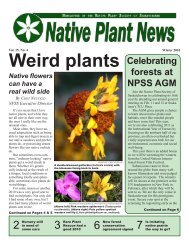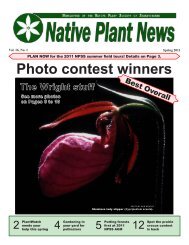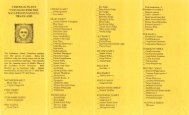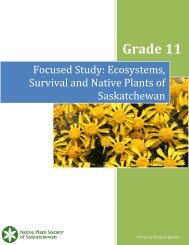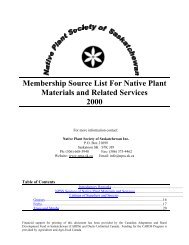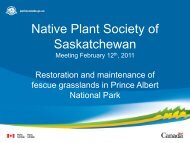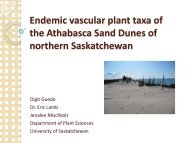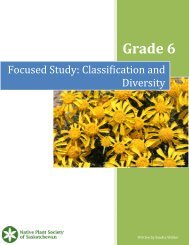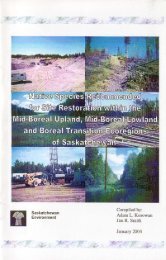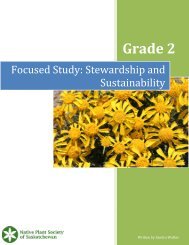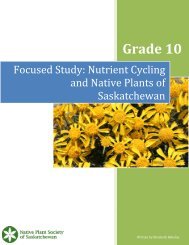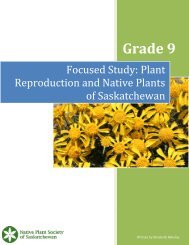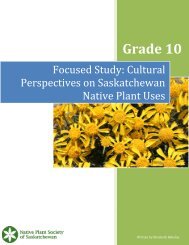Saskatchewan Guidelines For Use Of Native Plants In Roadside ...
Saskatchewan Guidelines For Use Of Native Plants In Roadside ...
Saskatchewan Guidelines For Use Of Native Plants In Roadside ...
Create successful ePaper yourself
Turn your PDF publications into a flip-book with our unique Google optimized e-Paper software.
<strong>Saskatchewan</strong> <strong>Guidelines</strong> <strong>For</strong> <strong>Use</strong> <strong>Of</strong> <strong>Native</strong> <strong>Plants</strong> <strong>In</strong> <strong>Roadside</strong> Revegetation<br />
Field Guide<br />
It may be beneficial to link the timeline, list of people involved and the budget, so that<br />
every step of the process has a related list of people and costs involved.<br />
2. Photos<br />
Take photos of the site and keep a record of the date. If possible, include a landmark in<br />
the photo such as a road sign. This will allow you to return to the same location to take<br />
comparative photos, so that changes can be tracked. Sites with a timeline of comparative<br />
photo records are often referred to as a photo plots.<br />
3. Vegetation Survey<br />
Next, have an experienced botanist do a survey of the roadside vegetation that will be<br />
affected by the construction. The surveyor should not only include the species names,<br />
but also the percentage of the community that they comprise. This will allow a<br />
comparison of the existing community to that proposed in the seeding guidelines and<br />
allow for possible modifications to the guidelines. Plant communities in adjacent areas<br />
should be recorded, as they may influence the revegetation site in the future. The<br />
surveyor should also make special note of any weeds on or near the site, particularly<br />
perennial weeds, as these will most likely pose problems in the future. <strong>In</strong> addition to<br />
weeds, the surveyor should make note of any ‘unusual’ areas on the site such as saline<br />
burnouts, sandy areas or depressions with water in them. The conditions that formed<br />
these areas will likely persist even after construction is finished and the species mix<br />
recommended for revegetation will probably not work in them as they were developed<br />
for ‘normal’ conditions in the area. Small amounts of seed adapted to these ‘unusual’<br />
areas such as the recommended mixes for saline or sandy areas will have to be used. <strong>In</strong><br />
the case of water-filled depressions, it may be acceptable to use the normal species mix<br />
suggested for the area, as most of the species are able to grow in moister conditions. The<br />
result will merely be higher, denser vegetation. It may be helpful if the surveyor sketches<br />
a map of the area, noting any features, or if they overlay features on an air photo. This<br />
will give a better visual conception of the site for anyone wishing to gain a better<br />
understanding of the situation.<br />
Figure 1. A botanist marking a transect<br />
line in preparation for a vegetation survey.<br />
Photo by Dean Nernberg, Canadian<br />
Wildlife Service/Environment Canada.<br />
4. Weed Control<br />
If perennial or other problematic weeds are found, it is<br />
advantageous to treat them even before construction<br />
begins. This is particularly important, as the site will<br />
not likely receive the recommended several years of<br />
weed treatment prior to revegetation due to the<br />
accelerated schedule of road construction. Although<br />
construction will remove the top growth if the soil is<br />
scraped away, the plants’ roots and rhizomes<br />
(horizontal creeping roots) may be left, enabling the



